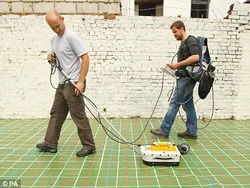
Ground penetrating radar services tend to be versatile enough to be useful for a number of applications, which range from finding hidden utility pipes as well as conduits within concrete slabs to locating historical treasures around excavation sites. This particular technology fundamentally draws a picture of what's buried underground by sending pulses of radio waves into the target area. Whenever the waves come across an obstruction, they create echoes which may be graphically shown on the GPR unit's screen.
There usually are 3 basic types of data which can be supplied by a ground penetrating radar device. The standard is 2D data, which is actually the raw data that is created by the GPR and shows up as a number of roughly-drawn lines upon the screen. 3D data is made by merging multiple 2D readings to produce 3D picture. Lastly, point data is actually created whenever the GPR is coupled with a global positioning system unit. The coordinates produced by the GPS tend to be blended with the GPR data to produce as-built drawings on CAD or even GIS software.
Ground penetrating radar services generally take about three approaches to a GPR survey. The first is to basically examine the site for indications to the desired targets, and then make use of this as a starting place for a much more detailed search. The GPR is actually moved across the suspect area right up until the target is found, and then marked on the ground or its coordinates logged using a GPS. Using mark out approach, a more systematic search is undertaken simply by dividing the search area straight into a grid and then moving the GPR across each individual square in orderly search pattern. Lastly, there is actually the generation of a 3D map of the search area, which can be produced using the information generated from earlier searches using the first couple of approaches.
Whenever using the services of ground penetrating radar services there tend to be three main considerations to bear in mind:
1. What sort of technology are they using? You may wish to use service which uses the most current GPR devices accessible to make sure you get the outcomes you need.
2. Do they have a highly trained staff? Even though it is easy to operate the GPR unit itself, you still want to have a skilled technician available to interpret the readings to ensure that absolutely nothing is missed.
3. Exactly how long have they been operating? You may wish to seek the services of a service that's well-established in your town to ensure that they are reliable and will supply you with the services that you might want.
There usually are 3 basic types of data which can be supplied by a ground penetrating radar device. The standard is 2D data, which is actually the raw data that is created by the GPR and shows up as a number of roughly-drawn lines upon the screen. 3D data is made by merging multiple 2D readings to produce 3D picture. Lastly, point data is actually created whenever the GPR is coupled with a global positioning system unit. The coordinates produced by the GPS tend to be blended with the GPR data to produce as-built drawings on CAD or even GIS software.
Ground penetrating radar services generally take about three approaches to a GPR survey. The first is to basically examine the site for indications to the desired targets, and then make use of this as a starting place for a much more detailed search. The GPR is actually moved across the suspect area right up until the target is found, and then marked on the ground or its coordinates logged using a GPS. Using mark out approach, a more systematic search is undertaken simply by dividing the search area straight into a grid and then moving the GPR across each individual square in orderly search pattern. Lastly, there is actually the generation of a 3D map of the search area, which can be produced using the information generated from earlier searches using the first couple of approaches.
Whenever using the services of ground penetrating radar services there tend to be three main considerations to bear in mind:
1. What sort of technology are they using? You may wish to use service which uses the most current GPR devices accessible to make sure you get the outcomes you need.
2. Do they have a highly trained staff? Even though it is easy to operate the GPR unit itself, you still want to have a skilled technician available to interpret the readings to ensure that absolutely nothing is missed.
3. Exactly how long have they been operating? You may wish to seek the services of a service that's well-established in your town to ensure that they are reliable and will supply you with the services that you might want.
 RSS Feed
RSS Feed